|
MAIN PAGE
> Back to contents
Genesis: Historical research
Reference:
Yachmenev O.Y., Vlasenko D.E., Garmaeva A.V., Vikulova N.O.
Rock art of Titovskaya Sopka: the results of the latest research
// Genesis: Historical research.
2023. № 12.
P. 190-208.
DOI: 10.25136/2409-868X.2023.12.68808 EDN: BUXCWR URL: https://en.nbpublish.com/library_read_article.php?id=68808
Rock art of Titovskaya Sopka: the results of the latest research
Yachmenev Oleg Yurievich
ORCID: 0000-0001-5761-129X
Student, Department of History, Trans-Baikal State University
672000, Russia, Zabaikalsky Krai, Chita, 140 Chkalova str.

|
yachmenev.oleh@yandex.ru
|
|
 |
Vlasenko Dmitrii Evgen'evich
ORCID: 0009-0002-6833-9273
Student, Department of History, Trans-Baikal State University
672000, Russia, Zabaikalsky Krai, Chita, 140 Chkalova str.

|
dmitrivlasenko2003@mail.ru
|
|
 |
Garmaeva Anastasiya Vasil'evna
ORCID: 0000-0002-2052-4018
Master's Degree, Department of History, Trans-Baikal State University
672000, Russia, Zabaikalsky region, Chita, 140 Chkalova str.

|
garmaevanastya@yandex.ru
|
|
 |
|
Vikulova Natal'ya Olegovna
ORCID: 0000-0001-9546-5879
Junior Researcher, Institute of Archaeology of the Russian Academy of Sciences
117292, Russia, Moscow region, Moscow, Dmitry Ulyanov str., 19

|
natasha_vikulova@mail.ru
|
|
 |
|
DOI: 10.25136/2409-868X.2023.12.68808
EDN: BUXCWR
Received:
25-10-2023
Published:
31-12-2023
Abstract:
The article presents the results of field work carried out in 2022-2023, during which the rock art monuments of the Titovskaya hill were re–examined - Sokhatinyi Kamen, Sukhotino–13 and Titovskaya Hill, presumably dating from the II millennium BC. The first millennium A.D. A new pisanitsa Gorge was discovered with two groups represented by images of lines and a zoomorphic figure. Much attention is paid by the authors to the recently discovered groups with ancient images on the planes of the Sokhatina Stone and Sukhotino-13, as well as to the analysis of the semantics and dating of all the monuments of rock art of the Titovskaya Hill. In the course of the study, the authors came to the conclusion that rock carvings, mainly on the Sokhatin Stone, were systematically applied by nomadic pastoral tribes, and could be used as ritual complexes. At the same time, the problem of preservation of monuments and their further museification within the framework of the Ethno-Archeopark "Sukhotino" is being raised. To clarify the more accurate chronology and semantics of the drawings, further research is needed using various interdisciplinary methods, such as ethnography, as well as natural science, which will allow for a more detailed study of these objects in terms of dating and cultural affiliation.
Keywords:
Titovskaya sopka, rock art, Sochatinny Stone, Titovskaya Sopka, Sukhotino-13, digital fixation methods, cultural interpretation, chronological interpretation, the culture of tile graves, the problem of safety
This article is automatically translated.
You can find original text of the article here.
Titovskaya sopka is a mountain range on the southwestern outskirts of Chita and belongs to a valuable natural and historical territory, which is a complex natural and archaeological monument of geomorphological, geological and paleontological type [26, p. 187]. The range of elevations of the mountain range is from 639.5 m to 944.9 m [8, pp. 546-547]. The first collections of archaeological finds on Titovskaya Hill were conducted by local historian A.K. Kuznetsov in the early twentieth century [9, p. 288]. In 1924, E.I. Titov undertook the first archaeological excavations during a school excursion. In the late 1920s, local historian A.I. Makhalov collected lifting material and excavated medieval burials [1, p. 186; 2, p. 203]. Subsequent studies of Titovskaya Hill are associated with the names of A.P. Okladnikov [24, p. 258], S.N. Astakhov [7, p. 140-141], I.I. Kirillov [9, p. 288; 11, p. 280-281; 18, p. 39-58], E.V. Kovychev [5, p. 133], M.V. Konstantinova [6, pp. 12-15] and others. In the 1950s and 80s, the following Paleolithic workshops named after A.P. Okladnikov [24, p. 258] and Skalnaya [7, p. 141], Russian settlement XVII-beginning, were discovered and studied. XIX century Zasoposhnoe [5, p. 133]. In preparation for the International Conference "Ancient Cultures of Mongolia, Baikal and Southern Siberia" in 2012, research was resumed on Titovskaya Sopka. During this time, work was carried out by detachments led by M.V. Konstantinov, P.V. Moroz, S.B. Vereshchagin, E.A. Filatov, N.O. Vikulova and others on the monuments of the Sukhotinsky group, workshops named after A.P. Okladnikov and Skalnaya, and a Paleolithic workshop named after S.N. Astakhov was opened [14, pp. 77-78; 23, pp. 36-38; 24, pp. 258-262]. According to the Center for the Protection of Historical and Cultural Heritage, 32 archaeological sites have been identified on Titovskaya Sopka. The uniqueness of the Titovskaya Sopka monument complex is due to the wide chronological range of objects from 300 thousand years to ethnographic modernity. As part of this work, the authors present the results of the latest research conducted in 2022-2023 using digital fixation methods on the monuments of Sokhatiny Kamen, Sukhotino-13, Gorge, Titovskaya Sopka. 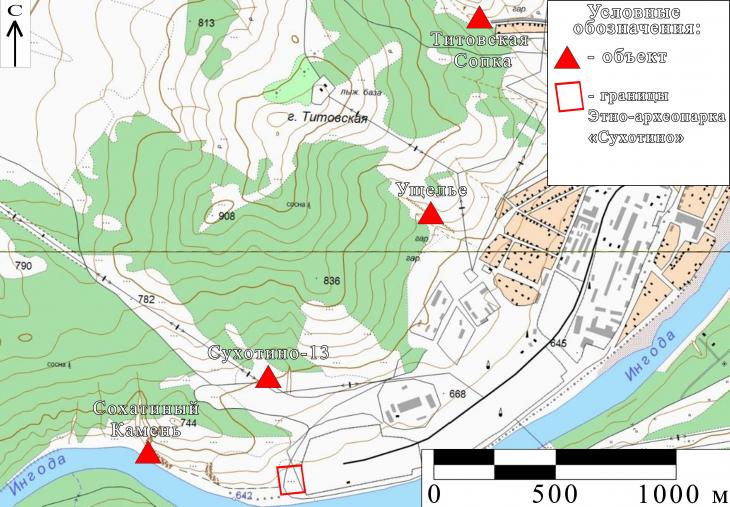
Fig. 1. Topoplan of the area Historiography of the issue. There are four rock art monuments on the territory of Titovskaya Sopka – Titovskaya Sopka, Sokhatiny Kamen, Sukhotino-13 and the Gorge. The objects are concentrated on the southwestern slope of the mountain range facing the Ingoda River {Figure 1}. The GPS coordinates of the objects are shown in Table 1. | Monument | Coordinates | | The Sochat Stone | 51°59'32.35"N 113°26'47.98"E | | Sukhotino-13 | 13 51°59'47.15"N 113°27'12.69"E |
| The Gorge | 52°0'5.55"N 113°28'0.5"E | | Titovskaya Hill | 52°00'37.25"N 113°28'11.65"E | Table 1. Coordinates of the Titovskaya Hill rock art monuments The first pisanitsa Titovskaya Sopka, which received the same name with the mountain range, was discovered in the 1950s by A.P. Okladnikov. The monument is located in a deep gorge, a rocky massif cutting through a hill, consisting of siliceous shale, near a meat processing plant and a psychiatric hospital that were previously located here. The drawings are concentrated on the left side of the gorge, on one of the vertical planes. In total, A.P. Okladnikov noted seven groups of drawings made in red-brown ochre. During the same period, a monument was opened – the Sokhatinyj Stone. It is connected with rocks that break off directly to Ingoda and are called Sukhotinsky. Eight groups of drawings painted with red ochre have been identified. The researcher recorded anthropomorphic figures, zoomorphs, lines, spots, symbols, fragments of drawings on both monuments [17, pp. 44-45]. In the 1990s, information on trans-Baikal writings was summarized by A.I. Mazin, who reported that the objects discovered by A.P. Okladnikov (Titovskaya Sopka and Sokhatinyi Kamen) were destroyed during the extraction of stone for construction work and the application of modern inscriptions [12, p. 25]. In 2017, pisanitsa Titovskaya Sopka was examined by I.A. Ponomareva. She noted 17 drawings on 3 planes. She managed to fix only 5 drawings on the same plane on the Sokhatin Stone [19, pp. 88-89]. In the 1970s, the Sukhotino-13 scribble was discovered, associated with a small rock located higher up the slope from the main rock massif. The only mention of the object is found on the topographic map in the field report of I.I. Kirillov for 1979 [10]. On the main panel there was a composition of a three-dimensional figure of a shaman, amorphous spots and lines. M.V. Konstantinov dated this group to the I millennium BC [6, p. 13]. At the same time, the drawings were not recorded and published. Under the plane with the drawings there was a Late Paleolithic workshop site dating back 12-15 thousand years. To the left of the scribble, a secondary Tunguska burial of the XVII century has been investigated. Next to the rock, down the slope, there are two burials of the culture of tile graves (I thousand BC) and the Burkhotui culture (first floor. The results of archaeological excavations have not been published, and are mentioned only in the article by M.V. Konstantinov [6, p. 13]. The research of the monument was carried out by the Chita archaeological team, under the leadership of I.I. Kirillov. Subsequently, the writing was subjected to significant anthropogenic impact, in connection with which the entire composition turned out to be under whitish mineral deposits [19, p. 88; 27, p. 53; 28, p. 229]. In 2017, I. A. Ponomareva monitored the drawings of Sukhotino-13, as a result of which she recorded 2 drawings on the same plane [19, p. 88]. Materials and methods of research. In the period from 2022 to 2023, the authors conducted monitoring of the Titovskaya Sopka rock art monuments (Titovskaya Sopka, Sokhatiny Kamen and Sukhotino-13, during which a new rock art monument was discovered, called the Gorge. We note in advance that virtually all the drawings of Titovskaya hill, today, are in a deplorable state. During the monitoring process, a visual examination method was used using the following methods: 1. The search method. Each object was carefully studied and marked on geolocation using the application "Locus map classic" (Table 1). 2. Photo fixation. The drawings were recorded with Canon and Nicon cameras, using slats and scale rulers. 3. Software processing. After the photo fixation, as part of the camera work, the photos were processed through a special program called aDStretch and rendered using the Adobe Photoshop 2023 application. The results of the study. The Sochat Stone. During the investigation, groups were found on the monument 1, 3, 4, 5, 6, 7, 8, previously studied by A.P. Okladnikov and considered lost for a long time. All the drawings on the Sokhatin Stone are made in dark red ochre.
In connection with this study, it was decided to create a new numbering system to eliminate the possibility of further confusion. This measure became necessary, since the groups of drawings reflected in the monograph by A.P. Okladnikov and V.D. Zaporozhskaya "Petroglyphs of Transbaikalia. Part 2" were numbered randomly, which created a number of problems when working with the monument. In addition, such changes are necessary, because as a result of monitoring, the authors found new compositions with drawings. 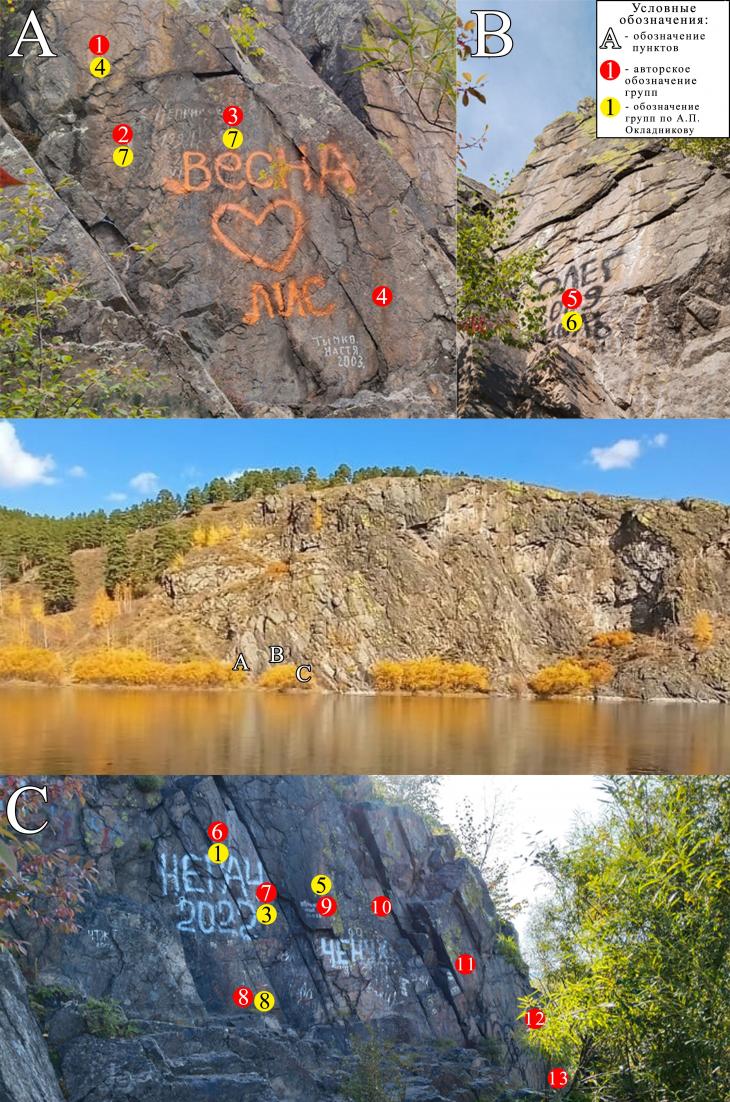
Fig. 2. General view of the Sochat Stone with the locations of the groups of drawings Group 1 (according to A.P. Okladnikov – 4) (Fig. 3.1) consists of a figure of an animal resembling a dog with a strongly elongated trunk and muzzle, under the belly of which there are four legs, a zoomorphic figure (1.4), seven bold lines (1. 14-20), three stripes and other images (1. 6-8). 
Fig. 3. Outlines of the main groups of drawings of the Sochatina Stone Group 2 (according to A.P. Okladnikov – 7) (Fig. 3.2) is an elongated vertical line with three lines on both sides. Group 3 (according to A.P. Okladnikov – 7) (Fig. 4) consists of a cross-shaped zoomorphic figure (3.8), lines (3. 1-7, 10, 14-16) and many fragments of images. 
Fig. 4. Group-3 after processing and rendering Group 4. The plot of the composition is based on many spots and fragments of lines. Group 5 (according to A.P. Okladnikov – 6) (Fig. 5). A large multi-figure composition consisting of anthropomorphic figures with rounded and wedge-shaped heads, some of which have been preserved fragmentally due to modern inscriptions (6. 12, 17; 6. 4; 6. 19, 22, 24; 6. 31, 36; 6. 33-35; 6. 37; 5. 38; 6. 27, 39-43), two three-dimensional figures of birds with wings spread wide (6. 10; 6. 5-6, 8-9), poorly preserved images of zoomorphic creatures (6. 13-14; 6. 25-26), sets fragments of drawings, spots and lines. 
Fig. 5. Group-5 after processing and rendering Group 6 (according to A.P. Okladnikov – 1) (Fig. 3.6) consists of one image of a man made in the traditional manner (6.1), one spot (6.2) and four lines from below (6. 2-6). Group 7 (according to A.P. Okladnikov – 3) (Fig. 3.7). A composition of a fantastic figure with a strongly curved left arm, an elongated wedge-shaped head (7.7), three long, almost identical lines (7. 2-4) and fragments of drawings. Group 8 (according to A.P. Okladnikov – 8) (Fig. 3.8) consists of large figures affected by weathering, or blurred initially when applied by an ancient artist. The plot includes an animal (possibly a dog) made in a schematic style (8.1), large blurred figures with small appendages in the center, sweeping limbs resembling an attempt to display an ornithomorph (8. 4-6) and blurred fragments of symbols (8. 2-3). Group 9 (according to A. P. Okladnikov – 5) (Fig. 3.9). A large composition with two half-anthropomorphic figures (8. 1, 10), a large anthropomorphic half-figure with a rounded head and arms bent at the elbows (8. 8), one little man, with an elongated (it is possible, what is blurred) with the right leg (8. 3) and two zoomorphic figures resembling small birds (8. 4, 11). Group 10 (fig. 3. 10). Consisting of a large human figure (10.20), a zoomorph (10.21), three clusters of spots applied in rows (10. 1-15; 10. 16-19, 10. 25-34). On the right, on the adjacent plane, there are three bright red spots (10. 22-24). Group 11. Most of it is difficult to read due to modern inscriptions and the pallor of the images. But, clusters of lines and spots arranged in tiers are well traced. Group 12 (fig. 3. 12). It is a large composition consisting of six anthropomorphic figures made in a traditional manner (12. 1, 12, 19-22, 25), one little man with a phallic symbol (12.11), a horned large figure (12.14), a thick line (12.26), spots and fragments of images. Group 13. A difficult to interpret uncharacteristic composition consisting of many spots made of dark red ochre, resembling a cross. Perhaps this composition belongs to the ethnographic era. Sukhotino-13. Pisanitsa is located in the southwestern part of Titovskaya hill. The drawings are focused on a small rock massif. During the survey, the authors identified new groups of drawings on Sukhotino-13. As a result, the object was divided into 4 groups (Fig. 6). 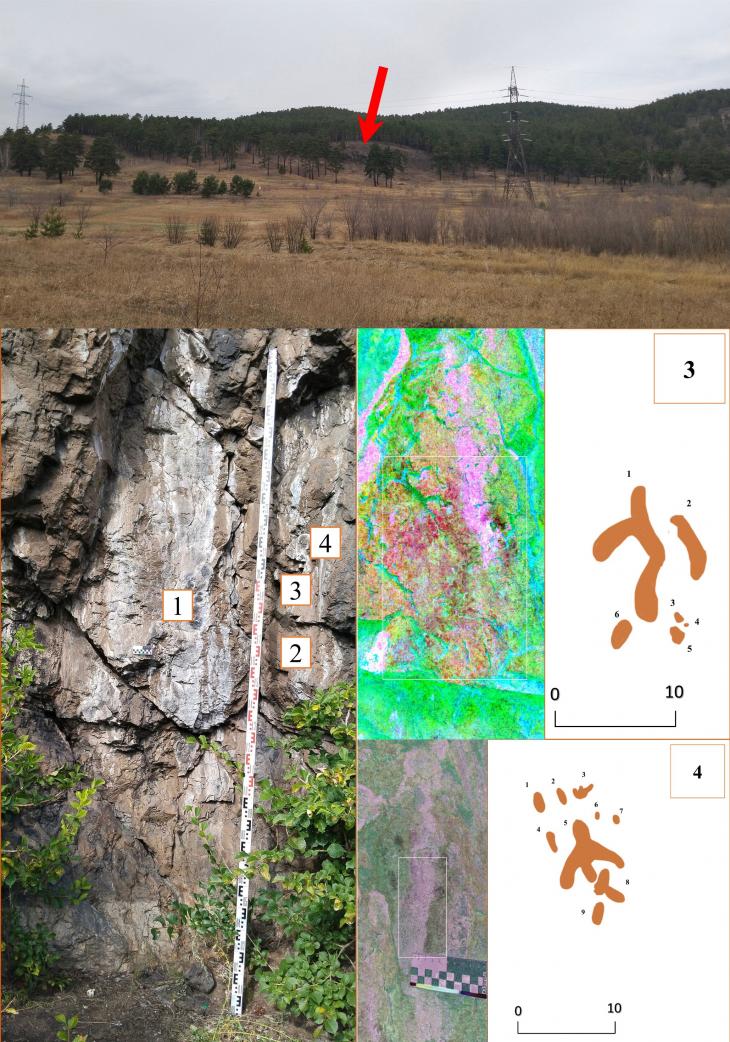
Fig. 6. General view of the monument Sukhotino-13. Dislocation of groups of drawings. Processing and rendering of groups 3 and 4
Group 1. It is located under the drips, from under which traces of bright red ochre are partially visible. Group-2 (Fig. 7). It is located to the right of group-1 on a plane with a slight slope, covered with a sun tan. The plot is based on two figures of anthropomorphs (2. 2, 7), made in a traditional manner, a zooanthropomorph (possibly an X-shaped figure, only inverted) (2. 9), rounded spots (2. 3, 8), two vertical lines (2: 4, 5), three small amorphous spots (2. 10-12) and remnants of drawings. 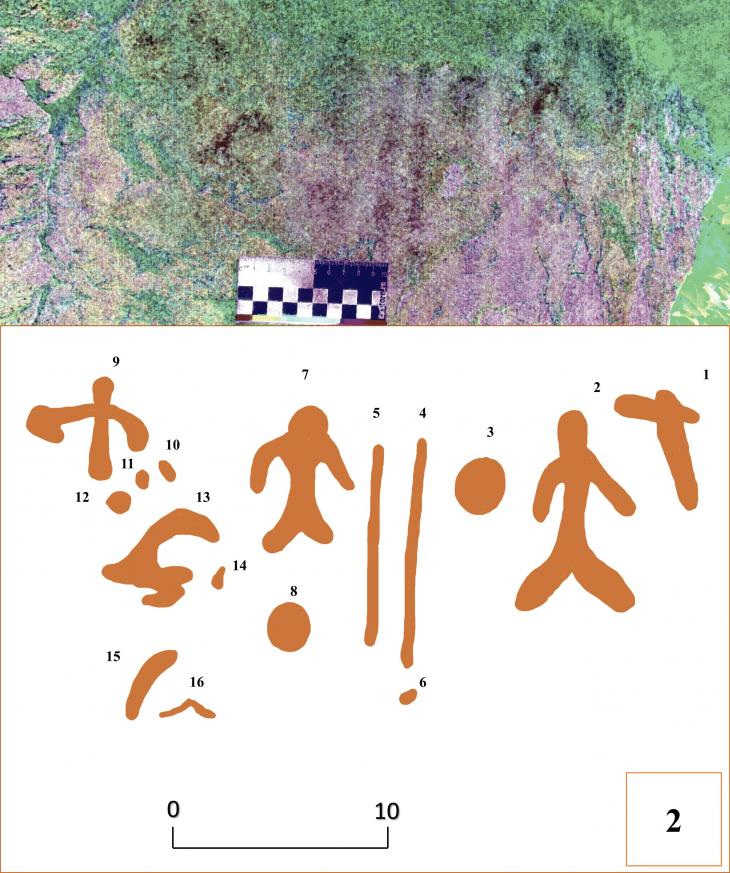 Fig. 7. Group-2 scribbles Sukhotino-13 after processing and painting Group 3 consists of fragments of an anthropomorphic figurine located on the left small angular plane (3. 1-6) (Fig. 6.3). Group 4 (Fig. 6. 4) is located on the right small angular plane, covered almost completely with a whitish deposit. The plot includes an anthropomorphic figurine (4-5, 8-9), seven spots and fragments of images (4. 1-4, 6-7). The gorge. The facility is located in the area of the garage cooperative, in a deep gorge on the eastern slope of Titovskaya hill. The monument was discovered by students of the Trans-Baikal State University in March 2022. The drawings are made in red ochre and are located at two points up the gorge (Fig. 8). 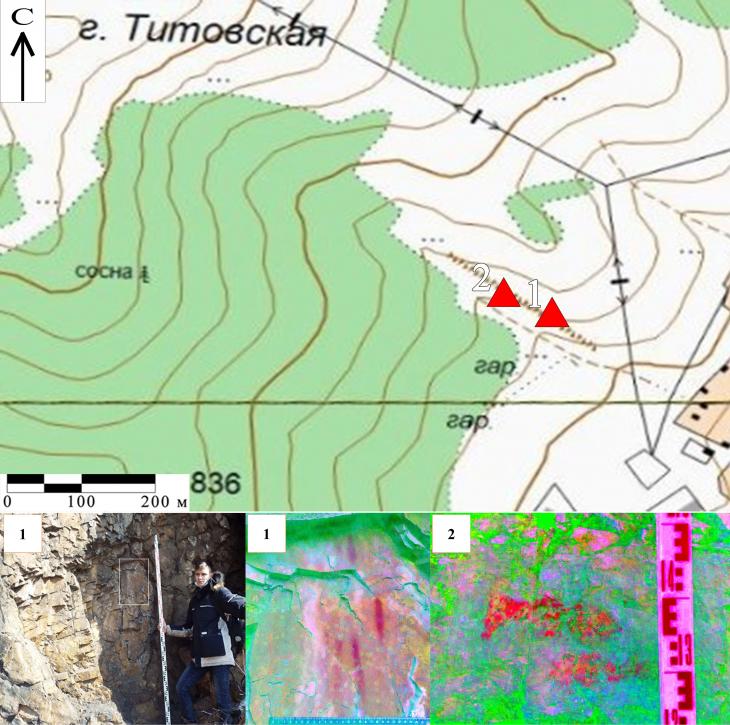
Fig. 8. Topoplan of pisanitsa Gorge. General view of the group-1. Processing of groups-1 and 2 Point 1 (Fig. 8. 1) consists of a group of vertical bold lines located in a small log of a rocky massif, and located at a height of 1.5 m from the foot of the cliff and about 5-8 m from the bed of a dried-up stream. Item 2 is an image of two figures, the upper one resembles a zoomorph, the lower one is an amorphous spot. The drawings are very blurred due to high humidity, dampness and dense vegetation in the depths of the gorge (Fig. 8.2). Titovskaya Hill. The monument is located in a deep gorge, in a rocky massif cutting through a hill near the former meat processing plant and a psychiatric hospital. For a long time it was believed that the group died, but in 2022-2023, according to the results of an inspection of the monument, it was revealed that the fifth group, found back in the 1950s by A.P. Okladnikov [17, p. 44], was completely preserved. Two groups of images made in bright red ochre, previously unpublished, were also identified (Fig. 9). 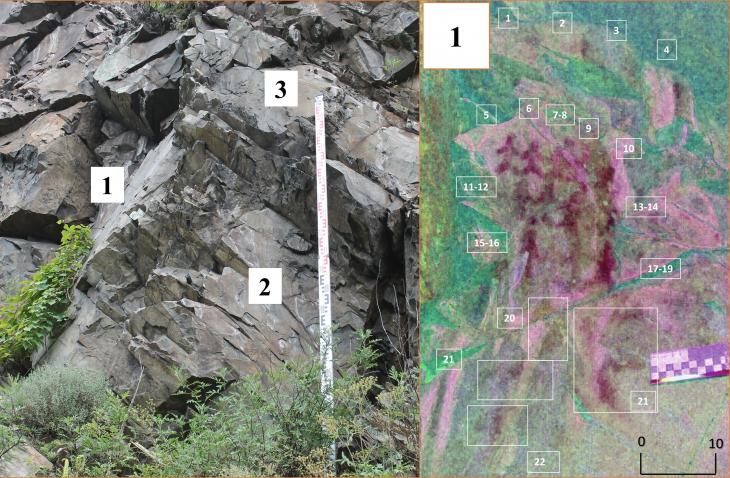
Fig. 9. General view of the pisanitsa Titovskaya Sopka with the dislocation of groups. Group processing-1 Group 1 (preserved) (according to A.P. Okladnikov – 5) is a three–dimensional composition located in a small recess and consisting of three tiers of anthropomorphic figures made in a traditional manner, holding hands, with rounded, wedge-shaped and slightly flattened heads. Some of the figures (1. 10, 13-14) are very blurred. Some of the images have completely faded 1. 13, 16-17, 20). Below the anthropomorphs are two ornithomorphic figures (1. 21-22), opposite which is a complex figure (1. 21). Fragments of drawings are scattered around the perimeter of the panel. Four amorphous spots were marked above the upper tier of the men (1-4) (Fig. 9. 1). To the right of group 1, at a height of 1.5 meters from the cliff ledge, on a protruding rock slab, group 2 is located. The plot of the panel is poorly preserved due to whitish streaks and destruction of the surface. Despite this, the silhouettes of some figures are recognizable. The composition is conditionally divided by a crack into three parts. The upper part has been preserved in the best possible way, and consists of figures of a little man, an anthropomorph with a stick in his right hand, a bird with six spots from below and a large figure of an anthropomorph similar to the one that A. P. Okladnikov discovered in the 1950s in group 6 [17, p. 44]. In other cases, the drawings are faintly distinguishable, for the most part they represent traces of blurred ochre. Above group-2 is group-3, the images of which resemble the letters of the modern alphabet. It is possible that they were applied in the ethnographic era. Discussion of the results of the study. There are more than 50 rock art monuments on the territory of the Trans-Baikal Territory, while studying which scientists face the problem of determining the age and interpretation. When analyzing the semantic content of objects, it is important to pay attention not only to the overall composition, but also to its individual parts. It should be noted that all the writings of Titovskaya Sopka, with the exception of the Gorge, feature anthropomorphic plots that practically do not differ from each other, since they are all schematic and connected by a common manner and style. A. P. Okladnikov, using ethnographic analysis and the method of correlation, attributed such figures of people to the Selenga style. He noted that they are most often grouped or arranged in a chain, often in several rows [17, pp. 65-78], as in group 1 of the Titovskaya Sopka writings. The most common anthropomorphic figurine is considered to be a full-length image, strictly in full face, whose arms are symmetrically lowered down the sides, as in the panel Sukhotino-13. Usually in the Selenga tradition there are images of birds. The most expressive ornithomorphic figures are present in the group-5 of the Sochat Stone. In addition, this tradition is characterized by large clusters of spots, most often arranged in rows, similar to what was found on the Sochatin Stone in groups 10 and 11.
Regarding schematics, A.P. Okladnikov writes that realistic art that existed in the Paleolithic era, in the society of farmers and cattle breeders, is replaced by abstract art [17, p. 90]. Probably, the tribes that painted the drawings on Titovskaya hill were predominantly pastoral. However, it is extremely difficult to determine their belonging to these images. For example, near Sukhotino-13 and not far from pisanitsa Titovskaya Sopka, detached single burials of the culture of tiled graves, whose representatives were nomadic pastoralists, were found. It is impossible to exclude the possibility that some of the drawings on the scribbles were created by representatives of this culture of the Bronze Age. I.A. Ponomareva believes that the development of the Selenga tradition falls at the end of the II millennium BC. At this time, in her opinion, a special cultural situation arose due to the appearance of the Kereksurs and their interaction with other peoples, including the culture of tiled graves. This, according to the researcher, was the reason for the surge of creative activity and the appearance of rock paintings [20, p. 306]. Back in the early 20th century, a number of scientists tried to culturally correlate the tombs of tile-makers with the Selenga writings, because most often they were located in close proximity to each other. Grave graves In 1935-1936, in the process of archaeological research in the Selenga River valley, researcher G. P. Sergeev noticed that some monuments with drawings were adjacent to ancient graves (we are talking about the culture of tiled graves). Examining the writings and burial at Sotnikovo village, he noted that the color of the ochre from the grave corresponds to the color of the pigment on the rock panel [15, p. 45]. A similar feature was noticed by researcher E.R. Rygdilon when working with drawings and graves of tile makers. He suggested that the ancient images may have common roots with the burial grounds of the late nomads [17, p. 5]. Subsequently, such a relationship will be discovered by other scientists, including A. P. Okladnikov, who dates the drawings of the "Selenga" tradition to the Bronze Age [17, p. 89]. Y. S. Grishin adheres to the position of A. P. Okladnikov regarding the relationship of the culture of tiled graves with the Selenga style. However, he notes that writings of this type most likely spread only in the last period of the existence of this culture [3, p. 167]. Judging by the typology, the grave at Sukhotino-13 is late. Perhaps some of the images on Titovskaya Hill were painted by later representatives of this culture. Researcher A.V. Tivanenko, regarding the Selenga drawings, comes to the conclusion that this group arose at the final stage of the Siberian bronze. In his opinion, the writings of this tradition belong to steppe pastoralists, who significantly influenced changes in worldview concepts and stimulated further creative activity, which flourished in the Early Iron Age. According to A.V. Tivanenko, this complex of drawings continued to exist until the first centuries of our era [22, pp. 55-56]. The Selenga tradition was spread far beyond the borders of Transbaikalia, its echoes are also found in Mongolia. E.A. Novgorodova notes the largest objects with fence plots, a significant part of which is concentrated in close proximity to Ulaanbaatar (their locality is Tangerine am), as well as in Bayan Zurkh (Khubsugul aimag) [16, pp. 90-91]. This testifies to the deep antiquity of the Selenga style, serious ethnocultural ties between the nomadic tribes of Mongolia and Southern Siberia. According to the researcher, the distribution of drawings applied with ochre (Eastern and Central Mongolia, Transbaikalia) coincides with the area of distribution of the culture of tile graves in the Bronze Age – I millennium BC [16, p. 94]. In addition to images of birds and anthropomorphic figures, the Selenga style is also distinguished by the use of fences of various shapes (round, rectangular and square). Usually these fences are filled with rows of spots or men, sometimes zoomorphic images are found. Ancient nomads added drawings of birds (eagles, falcons, etc.) next to or inside fences [17, pp. 64-78]. It is important to note that the presence of fences is not always mandatory when identifying the Selenga style. For example, in the case of Titovskaya Hill, there are no such fences, but there are clusters of spots and anthropomorphic figures. According to A.P. Okladnikov, human figurines can symbolize inhabitants of a certain kind. Spots in such cases indicate the number of livestock [17, p. 92]. Researchers pay great attention to the figures of birds, because for the ancient nomads, birds were the guardians and defenders of the collective [17, p. 76]. Therefore, in drawings with images of birds, fences with men are often found, as well as groups of anthropomorphic figures without fences. Birds could play the role of arbiter during shamanic rituals, as it was among the Altaians. Among some peoples, birds are revered as local deities. For example, A.P. Okladnikov mentions the role of the eagle in the Yakut tribes, where the eagle was associated with the cult of the sun and the supreme deity [17, pp. 117-118]. A similar point of view is expressed by A.V. Tivanenko, who also believes that clusters of spots, people and bird figures have a certain religious significance [21, p. 71]. Researcher N.N. Dikov refers such drawings to the middle and late stages of the Bronze Age, correlating them with images of birds on knives of the Ordos-Suiyuan culture of the Late Bronze Age [4, p. 49]. According to A.I. Mazin, anthropomorphic images in profile or full-face, as well as figures of birds, indicate that these drawings were created in the Bronze Age (I thousand BC). Fences with fillings inside, chains of men, rows of spots and solid lines are associated with the Neolithic era and the hunting style of the taiga traditions (2 thousand BC) [12, pp. 81-88]. An interesting point of view about the emergence of plots of single or grouped rows of men and spots is found in the works of A.D. Tsybiktarov. In his opinion, the semantic features of such images are associated with the cult of fertility of domestic animals, and relate to the Selenga-Daurian culture, originating in the III thousand BC, and especially spread in the II thousand BC [25, p. 12]. A.I. Mazin notes that the ancient peoples of Siberia and the Far East treated scribes with great reverence: they worshipped drawings, made altars under rocks and performed various kinds of rituals. Even in the modern era, some peoples offered small sacrifices to local spirits: cartridges, matches, coins, etc. Especially such a tradition, as the researcher notes, is found among the Tungus. Since ancient times, people have tried to associate drawings with hunting activities, to ritualize images on rocks. This leads to the presence of altars under most of the planes with ancient drawings [12, pp. 128-129]. However, so far no altars have been found under the drawings on Titovskaya Hill, although several promising sites have been noted for their identification. For example, in the case of the Sochat Stone, there is a convenient place for rituals, but it is located on an open rocky surface. As for Sukhotino-13, the presence of three graves from different eras (Bronze Age, Middle Ages, Modern times) definitely indicates the religious affiliation of this object.
Conclusion. Thus, thanks to the latest research, the ideas about rock carvings on the territory of Titovskaya Sopka have been significantly expanded. Previously unknown groups of drawings on Sokhatin Stone and Sukhotino-13 have been identified. It was possible to completely fix the ancient images and determine their number beforehand. These important discoveries demonstrate the significant potential of Titovskaya Sopka as a complex of archaeological sites and a complex of incandescent drawings, in particular. Previously, the drawings on Titovskaya hill date back to the II millennium BC- the first floor. I thousand A.D., and may refer to the creative and religious activities of the ancient nomads. It should be noted that for a thorough analysis of the Titovskaya Hill rock paintings, more precise research methods are required, including the use of natural scientific approaches. In addition, a new object was discovered – a Gorge. In general, the rock art monuments on Titovskaya Hill represent a valuable historical and cultural resource. Each drawing and composition is a testament to the creative expression and worldview of ancient peoples. At the same time, rock carvings can become important objects for the formation of tourist routes within the framework of the Sukhotino Ethno-Archeopark established in 2023 [13, pp. 16-17].
References
1. Alkin, S.V. (2009). Transbaikal ethnographer and archaeologist Elpidifor Innokentievich Titov. Siberia: magazine of Russian writers, 1. Irkutsk: Ircutsk writer, 182-194.
2. Gantimurova, M.I. (2011). Makhalov Andrey Ivanovich. Small Encyclopedia of Transbaikalia: Archeology. Novosibirsk: Nauka.
3. Grishin, Yu.S. (1981). Monuments of the Neolithic, Bronze and Early Iron Ages of the forest-steppe Transbaikalia. Moscow: Nauka.
4. Dikov, N.N. (1958). Bronze Age of Transbaikalia. Ulan-Ude: Buryat Complex Scientific Research Institute of the Siberian Branch of the USSR Academy of Sciences.
5. Kovychev, E.V. (2011). Zasoposhnoye. Small Encyclopedia of Transbaikalia. Archeology. Novosibirsk: Nauka, 133.
6. Konstantinov, M.V. (2022). On the possibility of creating a Historical and Cultural Museum on Titovskaya Sopka in the area of the Sukhotino rocks. Preservation of historical and cultural heritage: experience, problems and prospects. Chita: ZabGU, 12-15.
7. Konstantinov, M.V., Vikulova, N.O., Filatov, E.A. (2021). Astakhov and Transbaikalia. Notes of the Institute of the History of Material Culture. № 24. Sait Petersburg: IIMK RAN, 139-143.
8. Konstantinov M.V., Sinitsa S.M. (2009). Titovskaya Sopka. Small Encyclopedia of Transbaikalia: Natural Heritage. Novosibirsk: Nauka, 546-548.
9. Kirillov I.I. (2011). Titovskaya Sopka. Small Encyclopedia of Transbaikalia: Archeology. Novosibirsk: Nauka, 288–289.
10. Kirillov I.I. (1979). Scientific report on excavations in the Chita region in 1978. Settlement Sukhotino-4. Archive IA RAS. R-1, 4648. Chita.
11. Kirillov I.I., & Kirillov O.I. (2011). Sukhotino. Small encyclopedia of Transbaikalia. Archeology. Novosibirsk: Nauka, 280–282.
12. Mazin, A.I. (1986). Taiga writings of the Amur region. Novosibirsk: Nauka.
13. Markov, N.S. (2022). Museum-archaeological-ethnographic complex "Sukhotino" in the structure of the city of Chita as a new trend in urban development. Objects of archaeological heritage. Preservation of historical and cultural heritage: experience, problems and prospects. Chita: ZabSU, 16-18.
14. Moroz, P.V. (2021). New objects of the Titovskaya Sopka in Eastern Transbaikalia. Upper Paleolithic of Europe: Time of cultural innovations: Abstracts of the international scientific conference, St. Petersburg, December 6–8, 2021. – St. Petersburg: Federal State Budgetary Institution of Science Institute of the History of Material Culture of the Russian Academy of Sciences, 142-145.
15. Nesterenko, V.V. (2012). Archaeological research by G.P. Sergeev in Transbaikalia. Humanitarian vector. No. 2. – Chita: ZabGU, 41-46.
16. Novgorodova, E.A. (1984). The world of petroglyphs of Mongolia. Moscow: Nauka.
17. Okladnikov, A.P., & Zaporozhskaya, V.D. (1970). Petroglyphs of Transbaikalia in 2 parts. Part 2. Leningrad: Nauka.
18. Okladnikov, A.P., & Kirillov, I.I. (1980). South-Eastern Transbaikalia in the Stone and Early Bronze Ages. Novosibirsk: Science. Sib. Department.
19. Ponomareva I.A. (2018). Research of rock art monuments in the Trans-Baikal region in 2017. Humanitarian Vector. Vol. 13. No. 6. Chita: ZabSU, 82-93.
20. Ponomareva I.A. (2022). The world of zoomorphic images of the Selenga rock art tradition of Transbaikalia. Study of the ancient history of Northern and Central Asia: from origins to the present. Novosibirsk: Institute of Agricultural Sciences SB RAS, 305-308.
21. Tivanenko, A.V. (1990). Ancient rock art of Buryatia. Novosibirsk: Nauka.
22. Tivanenko, A.V. (1981). On the dating of the “Selenga” petroglyphs of Transbaikalia. New in the archeology of Transbaikalia. Novosibirsk: Nauka, 50-56.
23. Filatov, E.A. (2016). Sukhotinsky geoarchaeological complex: a scientific guide to the Paleolithic monuments of the Sukhotinsky geoarchaeological complex. Chita: ZabGU.
24. Filatov, E.A., & Filatova, M.O. (2020). Topographical studies of the workshop named after A.P. Okladnikov in Eastern Transbaikalia. Problems of archeology, ethnography, anthropology of Siberia and adjacent territories. Vol. 26. Sait Petersburg: IIMK RAN, 258-262.
25. Tsybiktarov, A.D. (2022). Selenga-Daurkaya culture of Southern Transbaikalia and Mongolia. World of Central Asia-V: collection. scientific Art. Novosibirsk: SB RAS, 11-13.
26. Yurgenson, G.A., Moroz, P.V., & Korsun, O.V. (2023). Stratovolcano Titovskaya Sopka as a complex monument of nature and ancient history within the city of Chita. Mineralogy and geochemistry of the landscape of mining territories. Rational environmental management. Modern mineral formation: tr. IX All-Russian symposium with international participation and XVI All-Russian. readings in memory of academician. A.E. Fersman. Chita: Express Publishing House LLC, 187-193.
27. Yachmenev O.Yu. (2022). Participation of students in ensuring the preservation of Sukhotinsky archaeological monuments. Preservation of historical and cultural heritage: experience, problems and prospects. Chita: ZabGU, 51-54.
28. Yachmenev O.Yu., Vlasenko D.V. (2023). Petroglyphs within the city of Chita (Trans-Baikal Territory). Akhinzhanov Readings (Almaty, April 28-30, 2023). Almaty: Institute of Archeology named after. A. H. Margulana, 227-230.
Peer Review
Peer reviewers' evaluations remain confidential and are not disclosed to the public. Only external reviews, authorized for publication by the article's author(s), are made public. Typically, these final reviews are conducted after the manuscript's revision. Adhering to our double-blind review policy, the reviewer's identity is kept confidential.
The list of publisher reviewers can be found here.
When, in the era of Perestroika, in the conditions of the collapse of the official communist ideology that had prevailed for seventy years, democratization and glasnost came to the social sciences, this immediately led to an increase in interest in history, both worldwide and domestic. At the same time, universal commercialization could not but cause the pursuit of sensationalism, which led to various pseudo-historical materials, including about the ancient period of history. It is obvious that even today there is a great need for truly scientific historical literature, among other things, in the field of archaeology. These circumstances determine the relevance of the article submitted for review, the subject of which is the rock art of Titovskaya Sopka. The author sets his tasks to consider the historiography of the issue, as well as to analyze the rock art of Titovskaya Sopka. The work is based on the principles of analysis and synthesis, reliability, objectivity, the methodological basis of the research is a systematic approach, which is based on the consideration of the object as an integral complex of interrelated elements. The scientific novelty of the article is determined by the very formulation of the topic: "in the period from 2022 to 2023, the authors monitored the rock art monuments of Titovskaya Sopka (Titovskaya Sopka, Sokhatinyi Kamen and Sukhotino-13), during which a new rock art monument was discovered, called the Gorge." Considering the bibliographic list of the article, its scale and versatility should be noted as a positive point: in total, the list of references includes 28 different sources and studies, which in itself indicates the large amount of preparatory work that its author has done. Among the works attracted by the author, we note the works of Y.S. Grishin, N.N. Dikov, I.A. Ponomareva and other specialists, whose focus is on various aspects of the study of ancient Transbaikalia. Note that the bibliography is important both from a scientific and educational point of view: after reading the text of the article, readers can turn to other materials on its topic. In general, in our opinion, the integrated use of various sources and research contributed to the solution of the tasks facing the author. The style of writing the article can be attributed to scientific, at the same time understandable not only to specialists, but also to a wide readership, to anyone interested in both ancient Transbaikalia, in general, and the rock art of the region, in particular. The appeal to the opponents is presented at the level of the collected information received by the author during the work on the topic of the article. The structure of the work is characterized by a certain logic and consistency, it can be distinguished by an introduction, the main part, and conclusion. At the beginning, the author determines the relevance of the topic, shows that "Itovskaya sopka is a mountain range on the southwestern outskirts of Chita and belongs to a valuable natural and historical territory, which is a complex natural and archaeological monument of geomorphological, geological and paleontological type." The work notes that "previously, the drawings on the Titovskaya hill date back to the II millennium BC- the first floor. I thousand A.D., and may relate to the creative and religious activities of the ancient nomads." Having examined the drawings in detail, the author comes to the conclusion that "each drawing and composition are evidence of the creative expression and worldview of ancient peoples," while, according to the author, "rock carvings can become important objects for the formation of tourist routes within the framework of the Ethnoarchaeopark "Sukhotino" created in 2023. The main conclusion of the article is that "thanks to the latest research, the ideas about rock carvings on the territory of Titovskaya Sopka have been significantly expanded," while previously unknown groups of drawings on Sokhatin Stone and Sukhotino-13 have been revealed. At the same time, the author states that "for a thorough analysis of the Titovskaya Hill rock paintings, more precise research methods are required, including the use of natural scientific approaches." The article submitted for review is devoted to an urgent topic, is provided with a table and 9 figures, will arouse reader's interest, and its materials can be used both in history lecture courses and in various special courses. In general, in our opinion, the article can be recommended for publication in the journal Genesis: Historical Research.
Link to this article
You can simply select and copy link from below text field.
|
|





